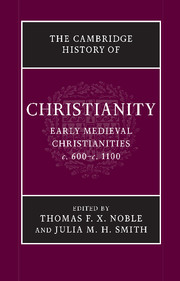Book contents
- Frontmatter
- Introduction: Christendom, c. 600
- Part I Foundations: Peoples, Places, and Traditions
- Part II Christianity in Confrontation
- Part III Christianity in the Social and Political Order
- Part IV Christianity as Lived Experience
- 18 Birth and death
- 19 Remedies for sins
- 20 Sickness and healing
- 21 Gender and the body
- 22 Sacrifice, gifts, and prayers in Latin Christianity
- 23 Performing the liturgy
- Part V Christianity: Books and Ideas
- Conclusion: Christendom, c. 1100
- Bibliographies
- Index
- References
21 - Gender and the body
from Part IV - Christianity as Lived Experience
Published online by Cambridge University Press: 28 March 2010
- Frontmatter
- Introduction: Christendom, c. 600
- Part I Foundations: Peoples, Places, and Traditions
- Part II Christianity in Confrontation
- Part III Christianity in the Social and Political Order
- Part IV Christianity as Lived Experience
- 18 Birth and death
- 19 Remedies for sins
- 20 Sickness and healing
- 21 Gender and the body
- 22 Sacrifice, gifts, and prayers in Latin Christianity
- 23 Performing the liturgy
- Part V Christianity: Books and Ideas
- Conclusion: Christendom, c. 1100
- Bibliographies
- Index
- References
Summary
In his famous treatise on the origins of ecclesiastical offices, Isidore, bishop of Seville (d. 636 CE), provides generations of Christian altar servants with explicit instructions as to the care and cultivation of the public persona of the priestly body. These directives include a section on the management of the masculine voice during the celebration of the liturgy. Here, Isidore counsels his priests to refrain from uttering obsence language, to be mindful of both gesture and gait, and to monitor the pitch and gravity of their elocutions when performing sacred rites. According to Isidore, the priestly voice should be clear and simple, and it should possess the full vigor of manhood; it should never make rustic or clownish noises, nor should it sound too servile or too lofty, too fractured or too delicate. The lector uses his voice as an instrument through which he penetrates the intellects of his hearers. Most importantly, the perfect liturgical voice should in no way sound effeminate. In order to avoid the risk of appearing femineus (“effeminate,” “womanly”), the lector’s movements must be infused with gravitas (“dignity,” “power”). Scholars of classical gender and sexuality would immediately recognize vestiges of Roman views on the elite male body in Isidore’s treatise on the clergy. In fact, the connection between Rome and Visigothic Spain is direct –the bishop of Seville summons the oratorical mastery of the first-century rhetorician Quintilian to revamp the image of the modern priest. Quintilian, in his Institutio Oratoria (c.90), provides meticulous instructions to neophyte orators as to the girding of the body, the proper positioning of the fingers, and somber striding.
- Type
- Chapter
- Information
- The Cambridge History of Christianity , pp. 433 - 452Publisher: Cambridge University PressPrint publication year: 2008



